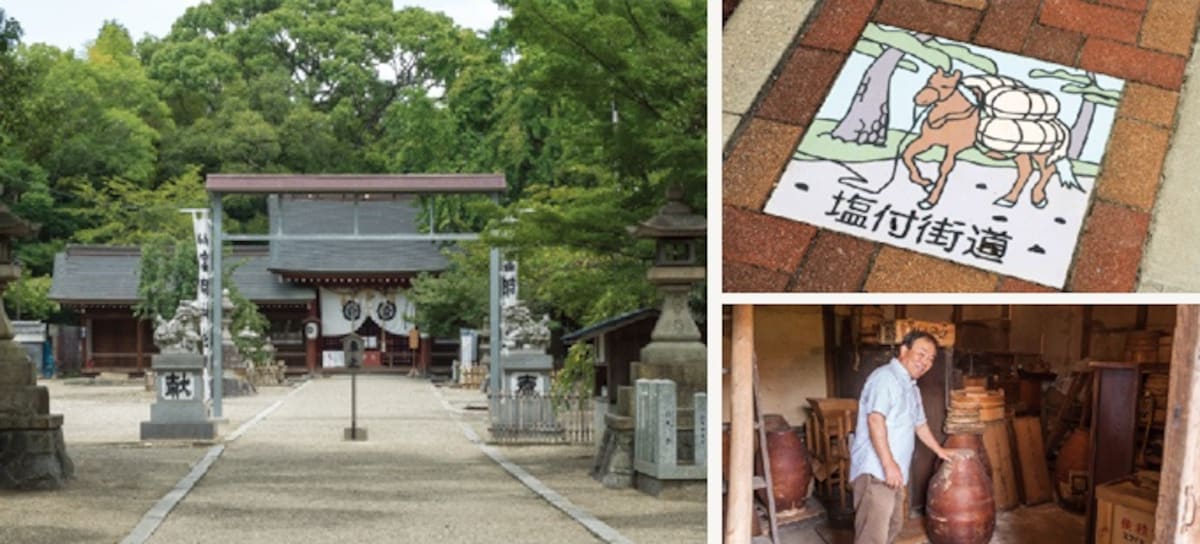The Salt of Life
There is a long-standing Japanese proverb that advises, “Give salt to your enemies.”
By Highlighting Japan
http://www.gov-online.go.jp/eng/publicity/book/hlj/html/201510/201510_13_en.html
The saying entered the Japanese vernacular after Uesugi Kenshin—a powerful daimyo (feudal lord) in the 1500s who ruled the province of Echigo (in modern-day Niigata Prefecture)—delivered salt to his long-time rival, Takeda Shingen, who controlled the province of Kai (in modern-day Yamanashi Prefecture), after neighboring lands blockaded Takeda’s salt supply. “Wars are to be won with swords and spears, not with rice and salt,” Uesugi declared.
The ocean was Japan’s sole source of salt before international trade began. This created a logistical challenge not only for daimyo in landlocked provinces but also for villagers living far from the coast who needed salt as a seasoning and food preservative. What was informally known as Salt Road—various routes that spanned the prefectures of Aichi, Nagano and Niigata—played a critical role in transporting this essential commodity to inland communities.
https://www.youtube.com/watch?v=UVtUHjuJ10s&feature=youtu.be
The salt transported via Salt Road was mainly harvested on the coastlines of the Pacific Ocean side of Japan, Aichi Prefecture’s coastal areas and near Niigata Prefecture along the Sea of Japan. Packed into straw sacks called tawara, the precious mineral was then carried through the mountains on the backs of horses, cattle or human porters to its primary trade destination: the aptly-named town of Shiojiri (shio means salt, and jiri refers to the end of the path) in Nagano Prefecture.
In Aichi Prefecture, Nagoya City’s Minami Ward marks the beginning of salt’s journey from the Pacific Ocean side. Coastal land reclamation has long since consumed the original salt beds near the sea, with housing covering the former salt pans, but signs and stone posts identify sections of the 10-kilometer (6.2-mile) stretch formally known as Shiotsuke Kaido (Salt Road) that led into the heart of the city close to Nagoya Castle, there intersecting with other routes heading inland.
A walking course between Sakurayama and Gokiso subway stations invites visitors to stroll approximately 1.5 kilometers (0.9 miles) along part of Shiotsuke Kaido. The path passes historical sites that include a few shrines and temples and a series of unique jizo statues—each with the head of a horse—that dot the road at intervals of 10 cho (a traditional unit, with 10 cho equal to about 1.09 kilometers/0.68 miles). These jizo allowed porters and other laborers to pray for safe passage and served as watering stations for the horses that hauled the heavy loads of salt.
https://www.youtube.com/watch?v=6eAeO_AQE-w&feature=youtu.be
Those transporters naturally stopped for refreshments near the path, and the walking course takes visitors past the traditional Japanese sweets shop of Takasago Honke. Founded over 60 years ago, this establishment re-creates the taste of shio daifuku (salt and bean mochi dumplings), which are sweets eaten since the Salt Road days that are filled with anko (sweet red bean paste), surrounded by a chewy mochi outer covering lightly flavored with salt.
Just over 40 kilometers (25 miles) inland from Nagoya, the riverside town of Asuke was a convenient way station along the route to Nagano known as Chuma Kaido. In fact, the Chinese characters of the town’s name indicate it is a place to “rest legs,” and the legs in need of rest were not just human, as packhorses were also given a respite from carrying the heavy tawara bundles weighing nearly 120 kilograms (265 lbs). At Yamashiroya, one of the few remaining lodges from the Salt Road era still in operation, the dining area adjacent to the Meiji Period (1868–1912) inn was formerly a stable for horses.
Several eateries in Asuke pay homage to the town’s salty history. At Bikkuriya, situated near the entrance to the town, visitors can sample a local specialty known as goheimochi—rice cakes carried by salt porters and other feudal-era travelers as a snack. Boiled rice is wrapped around a wooden stick and then typically coated with either miso paste or soy sauce—both of which include sea salt as an ingredient—before being grilled, resulting in a mouthwatering taste both sweet and savory.
Across the Asuke River and closer to the historical town center, a restaurant called Shio-no-Michizureya offers an authentic culinary experience—starting with the building itself, a 130-year-old Meiji Period structure that owner and Asuke local Yoshinobu Matsui remodeled with a group of volunteers. Matsui’s restaurant dishes up fresh, hand-pounded buckwheat soba noodles accompanied by a seaweed-sourced salt known as moshio. Matsui recommends eating the soba noodles first with only a pinch of moshio before dipping them in the mentsuyu noodle soup or adding other condiments.
Asuke performed another important function back in the Salt Road days: standardizing the salt shipments that arrived not only from Aichi but other areas such as the Seto Inland Sea. “The various salt bundles were packed in different weights, and had different properties depending on their origin,” explains Hiroyuki Okamoto, the ninth-generation operator of Tabacoya Shioza, once a salt and tobacco wholesaler. Okamoto’s ancestors and those of 12 other wholesalers sorted salt to achieve a standard taste and quality, and repacked it in tawara for the journey to Nagano.
Just a short drive further uphill and then over the forested Isegami Pass, which reaches an elevation of nearly 780 meters (2,559 ft), is the old mountain valley town of Inabu.
Since the pass was one of the most difficult to cross along the Chuma Kaido, Inabu became an important stopping point where tired transporters would rest, stay the night and change their horses. In its heyday the town was lined with salt wholesalers, traditional inns and stores, making for a bustling scene with several hundred people passing through each day. Though the town is quieter now, some of those quaint wooden shops still flank its streets.
Vehicles have long since been replaced horses, and gasoline and natural gas are now transported instead of salt along Chuma Kaido (now National Route 153) between Aichi and Nagano. Nevertheless, the importance of this route remains unchanged.




